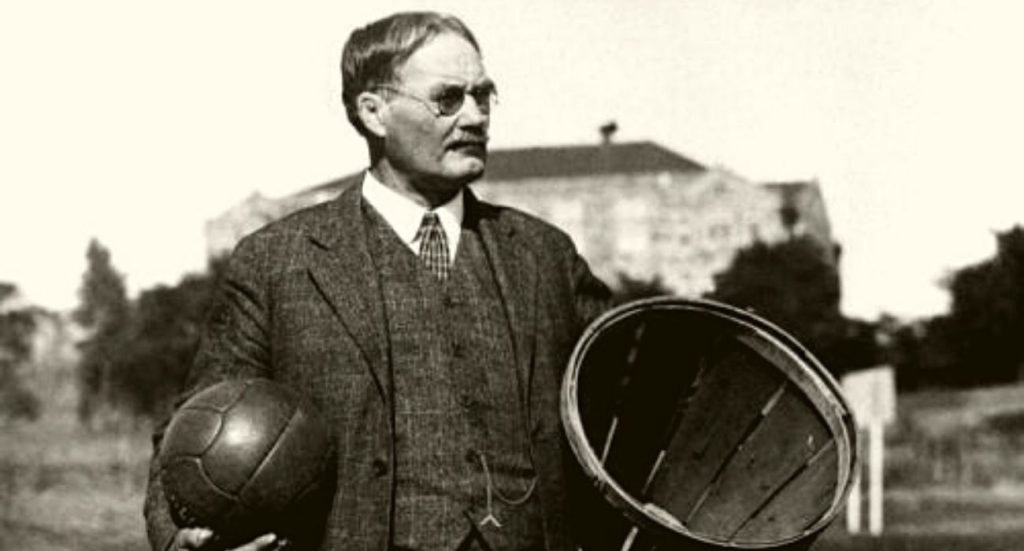
History of Basketball
The history of basketball begins way back in the year 1891. It was a Canadian physical education instructor by the name of James Naismith who introduced the game of basketball to the world.
He was born in Ontario and taught physical education at McGill University and Springfield College in Springfield, Massachusetts. James Naismith, during his stint with Springfield College, a YMCA training school during that time, invented the indoor sport with able support and guidance from the American phys-ed specialist Luther Hasley.
The game commenced with 18 men at Springfield College in Massachusetts. Naismith was given a deadline of 14 days to create an indoor game that would provide “an athletic distraction” (in the words of Hasley) to the nasty and disorderly class. It was a tough call for Naismith, who had to exercise a lot of patience and infuse positive enthusiasm into the minds of his students to engage in an outdoor game that was to be played indoors in the best way possible. He recalled a game he used to play as a child and improvised on its concept.
Naismith was instrumental in laying down 13 rules for the basketball game. The rules stated that the ball should be thrown in any direction with one or both hands. He made it clear that a person could not run with the ball. The player should throw it from the place from which he caught the ball in the first place. Players had to refrain from using the fist when handling or batting the ball. He had termed shouldering, holding, tripping, pushing or striking in any way of an opponent as a foul in the first instance. If things of this nature happened the second time, the person who caused the infringement of the rule would be disqualified or would not be substituted at all. If any side made three consecutive fouls, it was to be counted as a goal for the opposing side.
Naismith also made it clear that if the ball went out of bounds, it had to be thrown into the field of play by the person touching it. This player had the right to hold the ball for only five seconds. If held longer, the chance to throw went to the opposing side. He gave special importance to the umpire who had to judge the player and report to the referee when players made three consecutive fouls. He defined the time period of the game as being comprised of two fifteen-minute halves with fifteen minutes breaks in between. Naismith concluded that the side making the most goals was to be termed as winner.
The game caught the fancy of the YMCA class and the popularity of the game grew, though Naismith quietly shied away from taking any credit for his invention. He wanted the game to be enjoyed as a recreational activity, but he never imagined that the game would soon develop into a passionate and intensely competitive sport. Naismith’s moment of glory came, however, when he was invited by the National Association of Basketball Coaches (NABC) to witness basketball become an Olympic sport at the 1936 games in Berlin. He passed away in 1939 and since then the game has grown in fame and prosperity the world over. In 1959, James Naismith entered the Basketball Hall of Fame (called the Naismith Memorial Hall of Fame)
The first formal rules for the game were introduced in 1895. It was not until 1897 that teams of five players on each side became standard in the history of basketball. Iron hoops and a hammock style basket came into existence in 1893. A decade later, open-ended nets came into existence, which did away with the practice of manually retrieving the ball from the basket each time a goal was made. After the end of World War II, there was a need to infuse sports entertainment into the large sports arenas during the times not occupied by pro hockey and college basketball games. This gave rise to the history of basketball in its pure, professional championship format.
Walter Brown of Boston introduced professional basketball in the form of the Basketball Association of America in the summer of 1946. The esteemed members of the new league were New York, Philadelphia, Cleveland, Pittsburgh, Washington, Detroit, Chicago, Providence, Toronto, St. Louis, and Boston. The league played in big arenas in large cities but the players were not as talented as the ones in the National Basketball League, the recognized league operating chiefly in smaller cities in the Midwest. However, some people from the NBL joined the fray and the strength of B.A.A picked up as college stars and fresh young talent entered the league. The regular season started and the Washington Capitols were the clear winners in the Eastern Division, with the Philadelphia Warriors taking second place and the New York Knickerbockers grabbing the third and final playoff spot.
The Western Division had the Chicago Stags narrowly edging out the St.Louis Bombers with a one-gain tiebreaker at the end of the regular season. The Cleveland Rebels acquired the third playoff spot. The playoff system devised by the league pitted the first ranking teams, the second ranking teams and the third ranking teams against each other in the opening round. The games began with the Stags usurping the Caps in six games and Philadelphia outdoing St. Louis in a three-game showdown of second-place finishers, while New York defeated Cleveland in three games in the third bracket. The Warriors defeated the Knicks to move into the finals with the Stags.
The finals of the first championship of BAA (the present day NBA) opened in Philadelphia with Joe Fulks scoring 37 points, leading his Warriors to a victory against the Stags. Though the Stags won the fourth game, the Warriors won the overall title with an 83-80 victory with a 34-point contribution from Fulks. Howie Dallmar is credited with hitting the winning basket to break an 80-80 tie, with only a minute left before the finish of the game.
The history of Basketball has witnessed a lot of landmark events that have increased the popularity of the game to dizzying heights. It is almost a second religion to the sport-loving people in the US. No doubt, basketball is heralded as a sport that gives a healthy balance to the physical, mental and spiritual state. This is truly the game that keeps you on your toes!

